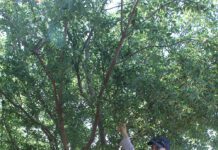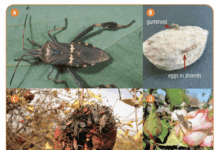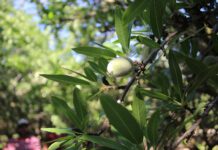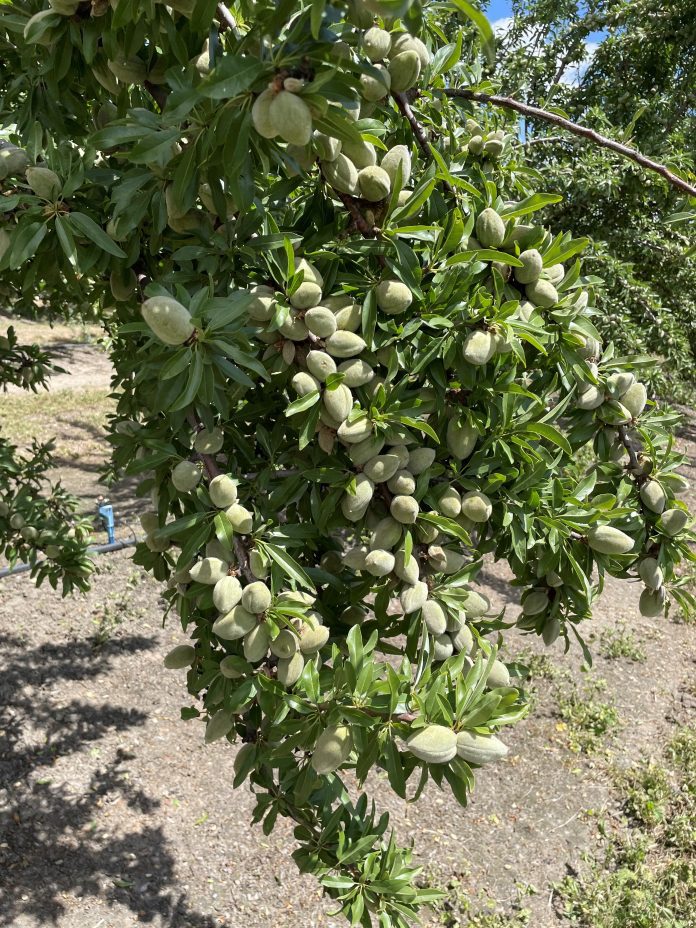
Franz Niederholzer, UCCE farm advisor for Colusa and Sutter/Yuba counties, has witnessed a dramatic growth in the production of self-fertile almond varieties over the past few years. And, provided the varieties continue performing as they have, he sees no change to this growth trajectory.
“10 years ago, Roger Duncan (UCCE Stanislaus County) said he thought that self-fertile varieties had the potential to change the industry, and he was right,” Niederholzer said. “But it has to be varieties that fit the entire industry, from the grower up to the consumer.”
Self-fertile varieties certainly have the attention of breeders, Niederholzer said. He noted that a big portion of the UC variety trials are planted to self-fertile, both public and private varieties. And growers are finding multiple benefits in the varieties.
“I think the biggest thing growers like is the reduction in the overall cost of production,” he said. “[The savings on] bees are a big part of it, because that is one big check that growers write, but all the other factors are a part of it, too.”
To get an idea of the growth curve of self-fertile almond varieties in California, in 2012, according to USDA, 2,430 acres were planted to the most popular variety Independence. A decade later, in 2021, 78,909 acres were planted to the Zaiger Genetics variety that is licensed by Dave Wilson Nursery, making it the fifth most popular almond variety in California.
Shasta, the second-most-popular self-fertile variety, has increased its presence from 120 acres in 2015 to 8,732 acres last year.
“I think more people will plant self-fertile varieties,” said Tom Burchell of Burchell Nursery in Oakdale, which introduced the Shasta variety in 2015. “I think Nonpareil is still king, so I don’t think the self-fertile varieties will take that over. But if growers look at their input costs, if growers have limited amount of acres to plant, I think self-fertile has a place.”
Reid Robinson, CEO of Sierra Gold Nurseries in Yuba City, which sells Independence, Shasta and Yorizane, a new self-fertile variety released by USDA, said the varieties are particularly adaptable to small acreages that are inconvenient to farm. “They can move in there and harvest these 10 to 15 acres in one shot. They can go over there and spray one time, go over there and shake one time. And they don’t have to bring in as many bees.
“It is just an efficiency-of-farming thing,” he said.
But the varieties are by no means isolated to small blocks, nursery executive said. “A guy just planted [the new Burchell self-fertile variety] Pyrenees in Chowchilla on 300 acres,” Burchell said. “So, I think they are being planted on both small acreages and large acreages in some places.”
Growing Familiarity
Growers also are getting more familiar with the trees, nursery executives said, and more comfortable planting and managing the varieties.
Because Independence is a smaller tree, for example, growers are planting them closer together than conventional varieties, Robinson said. And, he said, growers are discovering Independence does better on the more vigorous rootstocks. Also, the tree is easier to prune than more vigorous trees.
The Shasta variety, conversely, can require more aggressive pruning, Burchell said, but, here again, growers are learning how to prune the tree in a way that reduces their workload. “We are seeing with Shasta because it does crop up so much, they tend to weep over if you are not pruning it to strengthen the limbs, and you do need to tie it with a rope,” Burchell said. “A lot of growers don’t like that as it is a little bit extra work. But we are working on pruning techniques to strengthen those main scaffolds so that it can hold the heavier crop that does come with it.”
Issues with sticktights, which dogged the varieties in their early years, have been resolved, nursery executives said, primarily by waiting a little longer on harvest timing. And treating for bacterial diseases or other diseases generally is easier in self-fertile orchards, given that orchards are planted to one variety and one shot at the appropriate timing can provide the necessary control.
Also, growers typically get away with a single shake at harvest in self-fertile varieties, significantly reducing harvest costs and cutting down on dust, which can be an issue in some areas.
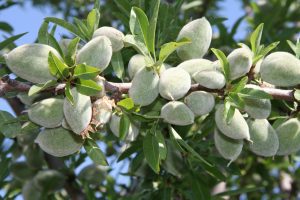
Lessons Learned in Pollination
And then there are the savings in pollination costs. At $200 a hive and with two to three hives required per acre to pollinate the conventional varieties, hive rental costs can be substantial. And while nursery executives are not saying no hives are needed in self-fertile plantings, the number of hives needed is scaled back dramatically.
“We recommend one hive to half a hive per acre,” Burchell said regarding Burchell Nursery’s self-fertile varieties. “The bees do help stir around or move around the pollen. We don’t recommend no bees.”
“It is all just about risk management,” Robinson said. “I would feel comfortable with half a hive an acre. I would feel more comfortable with one hive an acre. And I would want to know my bee supplier. That is something that tends to get lost in the translation here. A half a hive to one guy can be a full hive to another guy, depending on how many frames they have and depending on what condition they are in.
“If you have a good relationship with your beekeeper and you know the hives you are going to be getting are strong, then I would probably feel more comfortable with half a hive an acre,” Robinson said.
Niederholzer noted that the industry standard for conventional orchards of two to three hives per acre is based on eight frames per hive. And, he noted, evidence has shown that two strong hives per acre are as good or better than three weak hives in moving pollen around the orchard.
“Beekeepers point out that it is not how many boxes you have out sitting in the orchard,” Niederholzer said, “it is how many bees you have out there working the flowers. And the bees are counted by bee-covered frames and not hives.”
In certain areas, weather issues can play havoc with bee pollination, regardless of the number and strength of hives in an orchard, putting an added premium on self-fertile varieties.
“In the south, they have great bloom overlap with just two pollinizers, Monterrey and Nonpareil,” Robinson said. “They have longer blooms that match up and they have really long bee flight time where there is no rain and it is always warm enough for the bees to be flying. Up north, it can be cold, rainy, windy and we need more pollinizers. It is a different story.
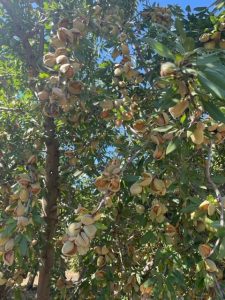
“There are kind of these little microclimates where having these self-fertile varieties makes a lot of sense in the north part of the state,” Robinson said.
One factor that could slow the rate of increase in self-fertile varieties is price. The premiums paid for Nonpareil are attractive to growers, executives said. And the cost of purchasing a self-fertile variety tree, with the exception of the public variety Yorizane, is higher than purchasing a conventional tree, given the royalty attached to the self-fertile varieties.
Also, growers are finding that some self-fertile varieties require more fertility and irrigation to maximize their yield potential.
Still, the attractions are significant, and as growers become more comfortable producing self-fertile varieties, obstacles that could slow acceptance appear to be going by the wayside.
“If the industry accepts the nut, I see the production of self-fertile varieties continuing to increase,” Niederholzer said.



